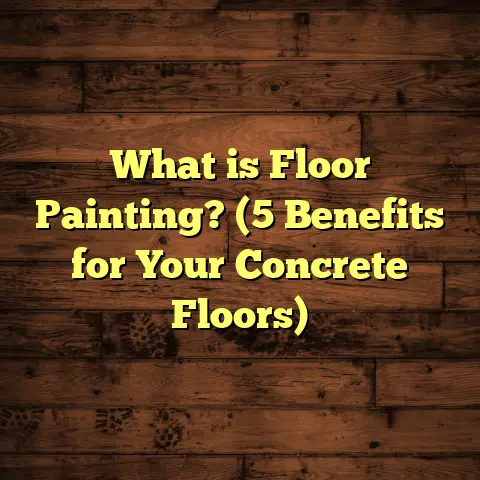What Is Laminate Flooring? (5 Key Benefits You Must Know)
I’ve always thought about how our living spaces should match the realities of our busy lives. Whether you’re juggling work deadlines, chasing kids, or just craving a cozy spot to unwind, what’s beneath your feet matters more than you might realize. Flooring is more than just a surface—it’s the backdrop for all the moments that make a house a home. Over the years, I’ve installed countless types of floors, but one type I keep coming back to for so many different situations is laminate flooring.
You might have heard about laminate before but wondered, “What really makes it different? Is it worth it?” Let me share everything I’ve learned about this flooring choice—from my hands-on experience in homes and commercial spaces to research-backed facts and real-world examples. By the end, you’ll know whether laminate flooring fits your lifestyle and budget—and why it might just be the smart choice you didn’t expect.
What’s Laminate Flooring All About?
When I first started in flooring, the term “laminate” sounded a bit technical and maybe even confusing. So let’s break it down simply: laminate flooring is a manufactured product made by layering several materials together to create a durable floor that looks like natural wood, stone, or other textures.
Here’s how it’s built:
- Top Layer (Wear Layer): This is a clear protective coating that shields the floor from scratches, stains, and fading. It’s what keeps your floor looking fresh even after heavy use.
- Design Layer: Underneath the wear layer is a high-resolution photographic image that mimics real wood grain, stone patterns, or other designs. This layer is what gives laminate its authentic appearance.
- Core Layer: Usually made from high-density fiberboard (HDF), this middle layer gives the floor its strength and stability.
- Backing Layer: The bottom layer adds moisture resistance and helps prevent the floor from warping.
Because of this layered construction, laminate flooring can provide many of the visual benefits of hardwood or stone without some of their drawbacks like cost or maintenance complexity.
How Does It Compare to Other Flooring?
When I talk to clients, I often hear comparisons between laminate and hardwood. Hardwood is beautiful and has been popular for centuries—but it can scratch easily and requires regular care like refinishing. Laminate provides a similar look but with a tougher surface that resists dents and stains better.
Compared with vinyl flooring, laminate tends to have a harder surface and often looks more like real wood. Vinyl can be softer underfoot but sometimes lacks the texture that makes laminate feel more natural.
Why Laminate Flooring Fits Different Lifestyles
I always ask clients about how they use their space because flooring needs vary widely depending on lifestyle. Here’s how laminate adapts:
- Active Families: With kids running around, spills happening, and pets zooming through the house, durability is key. Laminate’s tough top layer helps protect against scratches from toys or pet nails.
- Busy Professionals: If you travel often or don’t want to spend hours cleaning, laminate’s low maintenance nature is a big plus.
- Seniors and Comfort Seekers: While laminate isn’t as soft as carpet, it can feel warmer underfoot than tile. Using an underlayment adds softness and insulation.
- Stylish Renters: Because it’s easy to install and remove (in some cases), laminate is perfect for renters who want to upgrade their space without permanent changes.
I remember one client, a couple with two young kids and a dog, who were hesitant about hardwood floors because of scratches. After installing laminate in their kitchen and living room, they told me how relieved they were to see no damage after months of heavy use. The dog’s nails didn’t leave marks, and small spills wiped up with no fuss.
Five Reasons I Recommend Laminate Flooring
1. Durability That Holds Up Over Time
One of the biggest selling points for me—and for many homeowners—is how resistant laminate floors are to everyday wear and tear.
The wear layer on laminate acts like a shield against scratches from shoes, dropped objects, or pets. According to data from the North American Laminate Flooring Association (NALFA):
- Laminate floors resist abrasion up to 5 times better than many hardwood finishes.
- They also perform well under heavy foot traffic—ideal for families or commercial spaces.
I’ve installed laminates in offices where employees walk all day and in homes where kids race toys across floors—and in both cases, the floors stayed looking great for years.
2. Affordable Style That Doesn’t Compromise
Cost is often the deciding factor when choosing flooring. Hardwood floors can run between $8–$14 per square foot for materials alone. Then add installation costs, which can be high due to nailing or finishing requirements.
Laminate flooring usually costs between $1–$5 per square foot depending on quality and design complexity. Installation is simpler because planks click together without needing nails or glue, saving on labor expenses.
For homeowners on a budget who want wood-look floors without the sticker shock, laminate offers tremendous value.
3. Straightforward Installation Saves Time
Laminate’s click-lock system makes installation surprisingly quick and easy. When I first tried installing it myself on a weekend project, I was impressed by how fast the planks snapped together without glue or nails.
For professionals like me, that means faster job completion and less mess for homeowners. For DIY enthusiasts, it’s a rewarding weekend project that doesn’t require specialized tools.
In one recent job, I helped a client install nearly 500 square feet of laminate in two days—much faster than if they’d chosen traditional hardwood or tile.
4. Easy Maintenance for Busy People
Maintaining laminate floors is simple—usually just sweeping or vacuuming regularly and damp mopping when needed.
Because of the wear layer’s protection against moisture and stains, spills don’t soak in quickly like with hardwood. This makes cleanup faster and reduces worries about water damage.
I often remind clients not to use excessive water when mopping since standing water can still damage the core layer over time. But overall, laminate saves hours in upkeep compared to carpet or hardwood.
5. Vast Design Variety for Every Taste
One thing I love about laminate flooring is how far design has come. You’re not limited to just “wood look.” You can find:
- Textured woods with knots and grains
- Sleek stone or marble patterns
- Modern concrete or tile styles
- Exotic wood species reproductions
This variety allows homeowners to match their existing décor or create something fresh without spending extra on custom materials.
For example, one client wanted a Scandinavian-inspired minimalistic look with light floors that felt airy. We found a laminate style with subtle wood grain and a matte finish that perfectly fit their vision.
How I Use FloorTally for Accurate Cost Estimates
Budgeting is always on my mind during any flooring project. One tool I’ve come to rely on is FloorTally—an online platform that calculates flooring costs based on local prices for materials and labor.
Instead of juggling multiple quotes or guessing at waste percentages, FloorTally consolidates all those variables into one estimate. It even accounts for extra material needed due to cutting or mistakes—which happens more than you’d think!
For instance, when helping a client plan their basement remodel recently, we used FloorTally to compare costs between laminate and vinyl options side by side. It showed us not only material prices but also labor costs specific to our region.
This helped my client make an informed choice that balanced budget and aesthetics without surprises down the road.
Real-Life Case Study: A Family’s Laminate Journey
Let me tell you about a project close to my heart—a family renovating their kitchen and dining space. They had two toddlers who loved running around and a dog prone to muddy paws after walks. They wanted floors that could handle their lively lifestyle but also look great when entertaining friends.
We chose a high-grade laminate with an oak texture known for hiding minor scratches well. The installation took three days with minimal disruption to their schedule.
Six months later:
- No visible scratches despite daily chaos
- Spills cleaned up quickly with no staining
- Compliments from guests about how natural the floors looked
- Project cost came in 40% less than hardwood estimates
Their satisfaction reminded me why I trust laminate in so many homes where life happens fast but style matters too.
Frequently Asked Questions About Laminate Flooring
Can Laminate Floors Get Wet?
Laminate is water-resistant but not fully waterproof unless labeled otherwise. Standing water can seep into seams causing swelling over time. For bathrooms or basements prone to moisture, look for waterproof options or consider vinyl instead.
How Long Does Laminate Last?
With proper care, quality laminate can last 15–25 years or more depending on traffic levels. Some commercial-grade laminates are designed for even longer lifespans.
Will Laminate Sound Hollow?
Laminate installed over proper underlayment generally sounds solid underfoot. Without underlayment, it might feel slightly hollow or noisy when walking.
Is Laminate Environmentally Friendly?
Many brands now produce laminate with recycled materials in core layers and use low-VOC adhesives meeting indoor air quality standards like FloorScore certification.
Can Laminate Be Refinished?
Nope! Unlike hardwood that you can sand down and refinish multiple times, once laminate wears out you typically replace planks.
I hope sharing my experiences and knowledge about laminate flooring helps you see why it’s such a popular choice across so many lifestyles. Whether you’re renovating your family home or updating an office space, laminate offers an attractive balance of style, durability, ease of installation, and cost control.
If you want advice tailored to your specific needs or have questions about installation or maintenance tips, just ask—I’m always happy to chat about getting floors right for real life.





